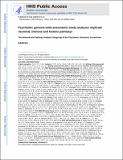Psychiatric genome-wide association study analyses implicate neuronal, immune and histone pathways
Abstract
Genome-wide association studies (GWAS) of psychiatric disorders have identified multiple genetic associations with such disorders, but better methods are needed to derive the underlying biological mechanisms that these signals indicate. We sought to identify biological pathways in GWAS data from over 60,000 participants from the Psychiatric Genomics Consortium. We developed an analysis framework to rank pathways that requires only summary statistics. We combined this score across disorders to find common pathways across three adult psychiatric disorders: schizophrenia, major depression and bipolar disorder. Histone methylation processes showed the strongest association, and we also found statistically significant evidence for associations with multiple immune and neuronal signaling pathways and with the postsynaptic density. Our study indicates that risk variants for psychiatric disorders aggregate in particular biological pathways and that these pathways are frequently shared between disorders. Our results confirm known mechanisms and suggest several novel insights into the etiology of psychiatric disorders.
Citation
Kent , L , IIBDGC & Network & Pathway Anal Subgrp Psyc 2015 , ' Psychiatric genome-wide association study analyses implicate neuronal, immune and histone pathways ' , Nature Neuroscience , vol. 18 , pp. 199-209 . https://doi.org/10.1038/nn.3922
Publication
Nature Neuroscience
Status
Peer reviewed
ISSN
1097-6256Type
Journal article
Description
G.B. and S.N. acknowledge funding support for this work from the National Institute for Health Research (NIHR) Mental Health Biomedical Research Centre at South London and Maudsley NHS Foundation Trust and King's College London. P.H.L. is supported by US National Institute of Mental Health (NIMH) grant K99MH101367.Collections
Items in the St Andrews Research Repository are protected by copyright, with all rights reserved, unless otherwise indicated.

